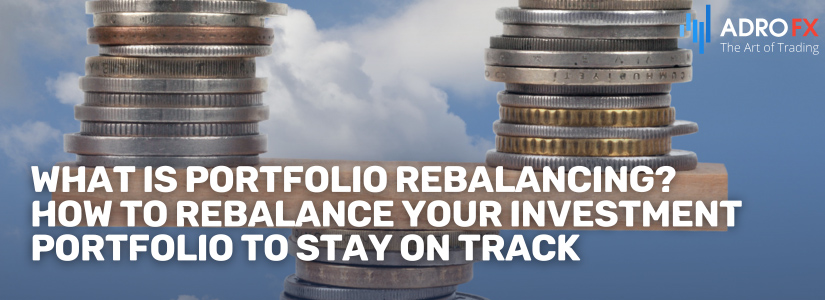What Is Portfolio Rebalancing? How to Rebalance Your Investment Portfolio to Stay on Track

Portfolio rebalancing is a strategic process that involves adjusting the proportions of assets in your investment portfolio to maintain a target allocation. Over time, the value of your investments can shift due to market fluctuations, which may cause your portfolio to stray from its intended balance. For example, if stocks outperform bonds, the equity portion of your portfolio might grow beyond the desired level, increasing your risk exposure.
The purpose of rebalancing your investment portfolio is to realign it with your original asset allocation strategy - whether it’s based on risk tolerance, time horizon, or financial goals. Maintaining a well-diversified portfolio across asset classes (like stocks, bonds, real estate, and commodities) is crucial to manage risk effectively. Portfolio rebalancing ensures that your investments remain in line with your goals, especially when markets are volatile.
Why Portfolio Rebalancing Is Important
Market fluctuations are inevitable. As asset prices rise and fall, the balance within your portfolio may shift, leaving you with a portfolio that no longer reflects your original investment strategy. For long-term investors, this drift can lead to unintended risks, such as an over-concentration in equities during a bull market or underexposure to growth assets during a bear market.
Portfolio rebalancing plays a key role in reducing these risks. By selling overperforming assets and buying underperforming ones, you can return your portfolio to its desired allocation, ensuring that you are not taking on more risk than planned. This disciplined approach helps protect your investments from market volatility and enables you to capitalize on opportunities, such as buying assets when they are undervalued.
Your investment portfolio should be a reflection of your financial goals, whether you’re saving for retirement, a home, or other long-term objectives. Over time, your goals may evolve, and so should your asset allocation strategy. Portfolio rebalancing allows you to periodically reassess and adjust your portfolio to keep it aligned with your current financial objectives.
For example, as you get closer to retirement, you may want to reduce your exposure to high-risk assets like stocks and increase your holdings in more conservative investments, such as bonds or fixed-income securities. Rebalancing ensures that your portfolio remains in sync with your evolving goals, providing a balanced mix of risk and reward tailored to your needs.
By consistently rebalancing your portfolio, you can maintain a diversified investment strategy, minimize risk, and stay on track to achieving your long-term financial targets.
Also read: The Significance of Diversifying Your Investment Portfolio

How to Rebalance Your Portfolio
Rebalancing your portfolio is a systematic process that requires careful attention to your asset allocation and investment strategy. Here’s a step-by-step guide to ensure your portfolio remains aligned with your financial goals:
Define Your Current Asset Allocation
Start by reviewing your existing portfolio to determine the current distribution of assets, such as stocks, bonds, real estate, or commodities. This is crucial because market performance often causes assets to deviate from their original target allocation. For instance, if equities have outperformed, their proportion in your portfolio might have grown disproportionately compared to bonds or other assets.
Compare with Your Ideal Asset Allocation
Your ideal asset allocation is determined by factors such as your risk tolerance, time horizon, and financial objectives. Compare your current allocation with this target allocation to identify which assets are overweight (greater than the target percentage) and which are underweight (less than the target percentage).
Methods to Rebalance
There are several methods to bring your portfolio back in line with your ideal allocation:
- Sell Overweight Assets
If a particular asset class, such as stocks, has grown too large, sell a portion to reduce its weight and restore balance.
- Buy Underweight Assets
Reinvest proceeds or add fresh capital to underweight asset classes to increase their proportion in the portfolio.
- Reinvest Dividends
If your portfolio includes income-generating assets, use dividends to purchase more of the underweight assets rather than reinvesting them in the same asset class.
Rebalancing is not about timing the market but maintaining discipline and sticking to your long-term investment plan.
How Often Should You Rebalance Your Portfolio?
There’s no one-size-fits-all answer to how often you should rebalance your portfolio. It depends on your investment strategy and market conditions. However, there are two common strategies investors can consider:
- Time-Based Rebalancing
This involves rebalancing your portfolio on a predetermined schedule, such as annually or semi-annually. This method ensures regular adjustments, regardless of market fluctuations. For example, you might choose to review and rebalance your portfolio at the end of each year.
- Threshold-Based Rebalancing
This strategy focuses on rebalancing when the allocation of an asset class drifts beyond a set threshold. For instance, if your target allocation for equities is 60%, you may choose to rebalance if it moves above 65% or below 55%. This approach is more dynamic and can help reduce the impact of large market swings.
Both strategies have advantages. Time-based rebalancing is simpler and more predictable, while threshold-based rebalancing allows for flexibility and responsiveness to market changes.
Ready to test your portfolio strategies without the risk? Start trading with a demo account on AdroFx! Experience real-time market conditions, practice rebalancing, and fine-tune your investment approach before committing real funds. Sign up for a free demo account today and take the first step toward mastering your investment strategy!

Portfolio Rebalancing Strategies
Effective portfolio rebalancing is a critical part of maintaining an optimal investment strategy, and the method you choose can significantly impact your long-term results. Investors typically face a choice between automated and manual rebalancing, with each approach offering distinct advantages depending on personal preferences, investment objectives, and the complexity of the portfolio.
Automated vs. Manual Rebalancing
Automated rebalancing has become increasingly popular with the advent of robo-advisors and sophisticated investment platforms. With this approach, technology manages the portfolio based on preset conditions, making it an ideal choice for passive investors who want to maintain their portfolio without the need for constant oversight. The system automatically adjusts the asset allocation when predefined thresholds are breached or at set intervals. This method ensures consistency and reduces the emotional biases that can lead to poor decision-making. Investors who prefer a hands-off approach or those who lack the time or desire to actively monitor their portfolio can benefit greatly from automated rebalancing, as it allows for efficient, systematic adjustments without the burden of constant involvement.
On the other hand, manual rebalancing offers a more tailored and personalized experience. Investors who prefer manual rebalancing typically have more control over when and how they adjust their portfolios. This method allows for flexibility, enabling investors to respond to market trends or specific financial goals. However, it demands more attention and discipline, as investors must regularly monitor their portfolios and make decisions that align with their long-term strategy. Manual rebalancing can be beneficial for those who are experienced and confident in navigating market complexities, as well as for investors who prefer to maintain a hands-on approach.
Ultimately, the choice between automated and manual rebalancing depends on the investor's desire for control, time commitment, and familiarity with market conditions. While automated rebalancing simplifies the process and reduces the emotional impact of trading decisions, manual rebalancing offers the chance to incorporate more strategic, customized adjustments.
Types of Rebalancing: Time-Based, Percentage-Based, Hybrid
Portfolio rebalancing strategies also vary in terms of when and how adjustments are made, ranging from time-based to percentage-based and even hybrid approaches.
Time-based rebalancing involves adjusting the portfolio at fixed intervals, such as quarterly, semi-annually, or annually. This method is straightforward and easy to implement, making it a suitable choice for investors who prefer a simple and predictable strategy. However, the downside is that it may not account for significant market movements between these intervals, potentially leaving the portfolio unbalanced for extended periods. Time-based rebalancing works best for those who want consistency and are less concerned with the short-term volatility of the markets.
In contrast, percentage-based rebalancing is more responsive to market conditions. This approach requires rebalancing whenever the asset allocation drifts beyond a predetermined percentage from its target allocation. For example, if an investor's target allocation for equities is 60% and that portion rises to 70% due to market gains, percentage-based rebalancing would trigger a readjustment. This method ensures that the portfolio remains aligned with the investor’s risk tolerance in a timely manner. However, it demands more active monitoring to identify when adjustments are needed. Percentage-based rebalancing is ideal for those who want to keep their portfolio closely in line with their targets without waiting for a fixed date to take action.
A hybrid rebalancing strategy combines the best elements of both time-based and percentage-based methods. With hybrid rebalancing, investors may schedule regular intervals for review, such as annually, while also setting a percentage threshold that triggers adjustments in response to major market shifts. This approach strikes a balance between simplicity and responsiveness, allowing investors to react to significant deviations while maintaining a structured routine. For example, if market movements drastically shift asset allocations within a few months of the last scheduled rebalancing, a hybrid method would allow for a timely correction before the next scheduled review.
Choosing the most appropriate rebalancing strategy depends on several factors, including the size of the portfolio, the investor’s risk tolerance, and the level of engagement they wish to maintain. Time-based rebalancing offers predictability, percentage-based rebalancing offers flexibility, and the hybrid approach ensures both regularity and responsiveness to market dynamics. Regardless of the chosen strategy, the key to success lies in the consistency and discipline with which rebalancing is applied, ensuring that the portfolio remains diversified and aligned with long-term financial goals.
Also read: Winning Stocks for Day Traders: Strategies for Selecting High-Profit Stocks

Common Mistakes to Avoid When Rebalancing
One of the most common mistakes investors make when rebalancing is overtrading. While it’s important to maintain a balanced portfolio, constantly shifting assets can lead to excessive trading, which in turn generates unnecessary transaction costs. These costs, along with potential tax implications from frequent buying and selling, can erode overall returns. Overtrading not only diminishes gains but also introduces emotional decision-making, which can lead to poor timing in the market. Successful rebalancing is about maintaining discipline, not constantly chasing short-term fluctuations.
Another pitfall to avoid is ignoring market trends that may warrant temporary allocation shifts. Rebalancing should not be done in isolation from broader economic conditions. For example, if certain sectors are undergoing significant structural changes or long-term growth shifts, it may be beneficial to allow for a temporary deviation from the target allocation. Completely disregarding market signals in the name of strict rebalancing can cause missed opportunities or unnecessary exposure to declining markets. The goal is to strike a balance between maintaining your long-term asset mix and being responsive to significant market developments.
Benefits of Rebalancing Your Investment Portfolio
Rebalancing offers the essential benefit of maintaining a balanced risk profile in line with your financial situation. As certain asset classes perform differently over time, your portfolio can become skewed toward higher-risk investments. This can expose you to greater volatility than you’re comfortable with. By rebalancing, you ensure that your portfolio reflects the level of risk you originally intended, allowing you to stick to your long-term financial plan while avoiding undue exposure to market swings.
Another advantage of rebalancing is the opportunity to capitalize on market corrections. When markets fluctuate, certain asset classes may become undervalued or overvalued. Rebalancing enables you to sell assets that have increased in value and buy those that have decreased, essentially allowing you to "buy low and sell high." This systematic approach helps you take advantage of market movements without relying on emotional decision-making or market timing. By following a disciplined rebalancing strategy, you can enhance your portfolio’s long-term performance while minimizing risks associated with market volatility.
Final Thoughts on Portfolio Rebalancing
Portfolio rebalancing is an essential tool for maintaining the health and performance of your investment portfolio over time. Markets are constantly shifting, with some asset classes performing better than others. Without regular rebalancing, your portfolio may drift away from your original risk tolerance and financial objectives. This can expose you to greater risks or reduced returns than you initially intended. By systematically rebalancing, you ensure that your portfolio reflects your investment goals, keeping your asset allocation in line with the level of risk you're comfortable with.
Moreover, rebalancing forces you to make disciplined decisions, such as selling high-performing assets that may now be overweight and reinvesting in undervalued assets. This strategy helps protect gains while ensuring that you continue to invest in growth areas. In essence, rebalancing offers a natural opportunity to sell high and buy low, turning market fluctuations into long-term advantages. It also helps mitigate emotional decision-making, keeping you focused on a structured investment plan instead of reacting impulsively to short-term market trends.
While rebalancing is key to staying on track, it’s important to strike the right balance between acting too frequently and letting your portfolio drift for too long. Too much activity can lead to unnecessary trading costs and tax implications, while ignoring rebalancing can expose you to risk. A consistent, well-thought-out approach will help you maintain stability, enhance returns, and move confidently toward your financial goals.
Now is the time to take control of your investment strategy by implementing regular portfolio rebalancing. Whether you’re just starting out or are an experienced investor, maintaining a balanced portfolio is crucial to staying on track. Consider seeking professional advice if you're uncertain about the best way to rebalance based on your financial situation. Start rebalancing your portfolio today to ensure you're prepared for future market fluctuations and set up for lasting financial success.
Take control of your financial future today by rebalancing your investment portfolio with AdroFx. Whether you're a seasoned investor or just starting out, our platform provides the tools and insights you need to maintain a balanced, diversified portfolio that aligns with your goals. Don't let market fluctuations derail your strategy - join AdroFx and keep your investments on track for long-term success. Sign up now and start trading with confidence!
About AdroFx
Established in 2018, AdroFx is known for its high technology and its ability to deliver high-quality brokerage services in more than 200 countries around the world. AdroFx makes every effort to keep its customers satisfied and to meet all the trading needs of any trader. With the five types of trading accounts, we have all it takes to fit any traders` needs and styles. The company provides access to 115+ trading instruments, including currencies, metals, stocks, and cryptocurrencies, which make it possible to make the most out of trading on the financial markets. Considering all the above, AdroFx is the perfect variant for anyone who doesn't settle for less than the best.










